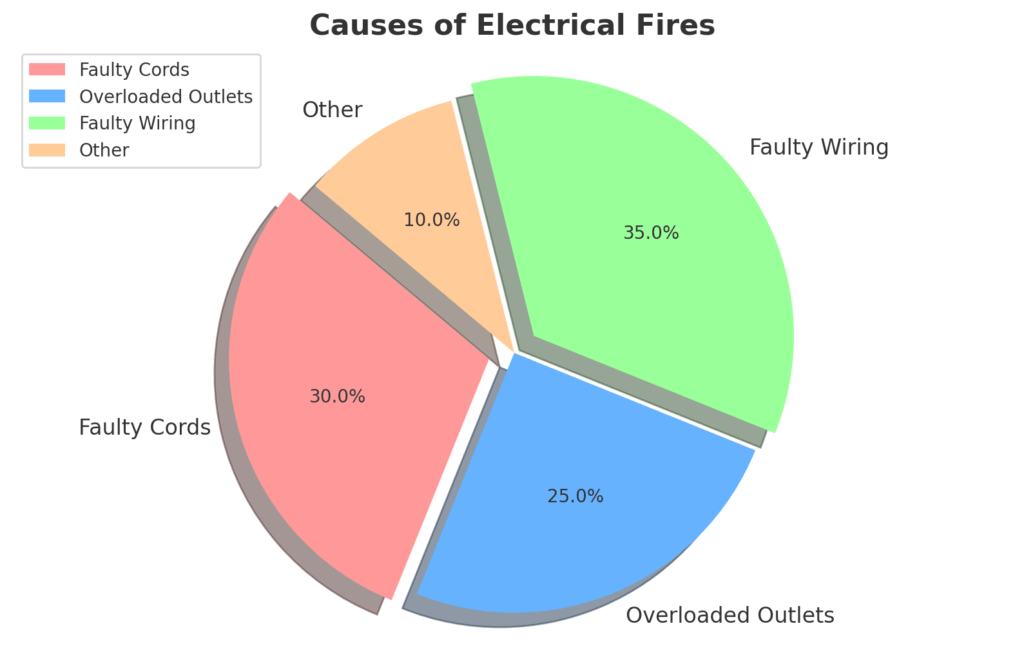How to Prevent Electrical Fires in Your Home
Electrical fires are a major safety concern for homeowners. According to the National Fire Protection Association (NFPA), electrical failures or malfunctions contribute to over 50,000 home fires each year. These fires result in around 500 deaths, 1,400 injuries and $1.4 billion in property damage annually.
Preventing electrical fires in your home starts with awareness. By understanding common causes of electrical fires and taking proactive steps, you can greatly reduce risks. This guide covers key strategies homeowners can use to enhance electrical safety.
Fire Risk Assessment Calculator
No Yes
Schedule a Professional Electrical Inspection
The first line of defense is having your home’s electrical system professionally inspected. This should be done regardless of your home’s age, but it is especially crucial for older homes.
Outdated wiring and noncompliant electrical work can increase your risks. Key hazard areas include:
Aluminum wiring – Used in homes built between 1965 and 1975. Prone to overheating and arcing faults. Should be thoroughly inspected.
Knob and tube wiring – Used in homes built before 1950. Plastic insulation often degrades over time. Requires replacement.
Unsafe DIY work – Faulty DIY electrical jobs often violate safety codes. Only a certified electrician should handle major electrical work.
The Copper Development Association recommends copper wiring to meet safety standards. Aluminum or copper-clad aluminum wiring should be replaced with copper by an electrician.
Look for an experienced home inspector or a licensed electrician to perform a thorough inspection of your electrical system. They will check for warning signs and recommend any required upgrades or repairs.
Regular inspections ensure your home’s electrical safety is maintained over time.

Replace Any Damaged Cords and Plugs
Faulty cords and plugs are another top cause of electrical fires. As cords age and fray, exposed wiring can ignite nearby flammable materials. Damaged plugs also create fire risks.
Watch for these warning signs of damaged cords and plugs:
- Exposed wiring from worn or cut insulation
- Burn marks or melting damage
- Cracking, fraying or splintering cords
- Loose plug prongs
- Warmth or discolouration at electrical connections
- RCDs that won’t reset
- Sparks from cords or outlets
- Odd smells from cords or outlets
Replace any cords or plugs showing these signs of damage. Do not try taping or repairing them, as this will not provide adequate safety. Purchase high-quality replacement cords and plugs from reputable suppliers.
Also, pay attention to cords hidden from view behind furniture or appliances. These are easily overlooked but may be damaged or deteriorated.
Need A Electrician In Perth?
BOOK ONLINE TODAY
Avoid Overloading Electrical Outlets
Overloading electrical outlets is another major fire starter. Too many devices plugged into a single outlet or power strip creates an overheated circuit.
The more wattage drawn through an outlet, the hotter the wires become. Excessive heat builds up and can ignite nearby combustibles. Warning signs of an overloaded outlet are:
- Warmth emanating from the outlet
- Discolored or melted plastic outlets
- Frequent blown fuses or tripped breakers
- Flickering or dimming lights
- Buzzing or sizzling from outlets
Avoid plugging high-wattage appliances like vacuums, hair dryers or heaters into the same outlet as other devices. Major appliances should have dedicated outlets.
Use power strips with built-in circuit breakers for multiple devices. Quality surge protectors cut off power if overloaded, preventing fires. Extension cords should only be temporary solutions, as they can overheat if used long-term.
Call an electrician immediately if you suspect an outlet is overloaded. Expanding your home’s amperage may be required to meet higher electrical demands.

Keep Flammables Away from Heat Sources
Strategic placement of flammable materials can reduce fire risks. The NFPA suggests keeping these common flammable items at least 3 feet away from any heat source:
- Furniture
- Curtains and drapes
- Paper and books
- Blankets and bedding
- Clothing and towels
- Cleaning supplies
- Holiday decorations
Take extra precautions when using high-heat electrical devices like space heaters. Never leave them unattended or place them near flammables. Also check your kitchen for hazards like curtains over stoves or paper towels near burners.
Proper placement safeguards your flammables from ignition in the event of an electrical fault. Be vigilant in rooms with many heat-generating electronics like home offices.
Watch for Signs of Faulty Wiring
Electrical shorts and arching faults within wires create extreme fire dangers. Unfortunately, faulty wiring is not always visible.
Be alert for clues of wiring issues, like:
- Frequent tripping of circuit breakers or blown fuses
- Lights flickering, blinking or dimming
- Uneven power distribution across circuits
- Burning smells from outlets or switches
- Unusual buzzing, cracking or humming from outlets
- Discolored or warm switch plates or outlets
- Tingling or shocks from appliances and electronics
If you notice these warning signs, immediately shut off the main power supply and call an electrician. Never ignore potential wiring problems. Flickering lights or slight shocks may signal serious hazards behind walls and require full inspections.
Faulty wiring is often caused by:
- Loose or corroded connections
- Nicked or cracked wire insulation
- Inadequate wire thickness for electrical load
- Poorly completed DIY jobs
- Environmental damage like rodents chewing wires
Only a certified electrician has the expertise to diagnose and properly remedy faulty wiring issues.
Implement Regular Electrical Maintenance
Even quality electrical systems require maintenance over time. Components degrade with exposure to heat, moisture and high use. Without diligent maintenance, safety risks escalate.
Typical maintenance should include:
Inspections – Schedule professional inspections every 5 years or sooner for older homes. Check for damaged outlets, cords and components.
RCD Testing – Test and reset RCD outlets monthly. These outlets help prevent shocks and electrocution.
Breaker Testing – Turn off and reset breakers annually to ensure proper operation. Breakers prevent overloads.
Wire Inspection – Inspect any accessible wiring for insulation damage, corrosion and connections issues.
Don’t assume new construction is immune to electrical issues. As homes settle, wiring connections can loosen over time. Environmental factors and high use also degrade components. Develop consistent maintenance habits regardless of your home’s age.
Implement Fire Safety Measures
Despite preventative steps, electrical fires can still occur without warning. Several fire safety measures can contain damage and save lives:
Smoke Alarms – Install ionization smoke alarms near sleeping areas and photoelectric alarms near kitchens, garages and bathrooms. Test them monthly.
Fire Extinguishers – Keep ABC dry chemical extinguishers nearby. Get training on proper use. Unfortunately, these extinguishers have limited effectiveness on electrical fires.
Evacuation Routes – Establish emergency exit plans and meeting places in case evacuation is necessary. Practice them with your family.
Electrical Shut-Off – Show all household members how to shut off the main electrical supply in case of an emergency.
Because electrical fires spread rapidly and restart easily, evacuation is the priority response. Only attempt to extinguish small fires that won’t block your exit path. The longer an electrical fire burns, the more toxic smoke is produced.
Take Proactive Steps
Electrical fires are largely preventable with proactive maintenance and awareness. Don’t take your home’s electrical safety for granted. Schedule regular professional inspections to identify and remedy lurking risks.
Performing a walkthrough inspection yourself periodically can also help spot potential issues. Look for warning signs like damaged cords or overloaded outlets. Take quick action to correct any hazards found.
Emphasize fire safety with smoke alarms, escape plans and fire extinguishers. While not always preventable, electrical fires are often controllable through preparation. Protecting your family starts with identifying and addressing electrical hazards before they become tragic fires.
Next Steps for Home Electrical Safety
Don’t put off giving your home’s electrical system a professional inspection, regardless of age. Preventative maintenance is the key to avoiding electrical fire disasters.
Contact a reputable and insured electrician today to schedule a full safety inspection. They can assess compliance with electrical codes and advise on any required upgrades or repairs.
Taking a proactive approach ensures your home’s wiring will be safe for years to come. Don’t wait until there’s an electrical problem or fire to take action. Make electrical safety inspections part of your regular home maintenance routine.




